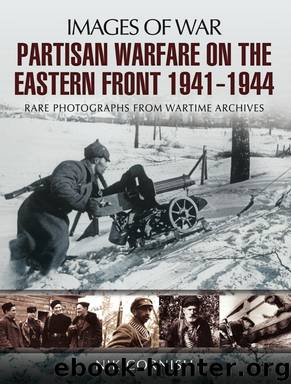Partisan Warfare on the Eastern Front 1941-1944 by Nik Cornish

Author:Nik Cornish
Language: eng
Format: epub
ISBN: 9781783830183
Publisher: Pen and Sword
Published: 2013-08-16T16:00:00+00:00
The wording is interesting as it offers no alternative to draft dodgers but death. Furthermore, as well as raising recruits it was also an attempt to reassert Soviet authority. Nor was it merely the 17-year-olds but everyone up to the age of 50 that was expected to answer the call, unless physically or mentally unable to serve. Useful a tool as conscription was, it proved to be a mixed blessing. The majority of the recruits had no training, lacked discipline and were concerned for the fate of their families left behind at the mercy of the occupation authorities. Often they were suspected, as they had not joined up earlier, of Fascist sympathies and collaborationist tendencies. Consequently, their every move was watched until they proved themselves reliable and only then would they be armed. Unsurprisingly, the morale of such men was low. Reports of these feelings found their way back to Moscow and when such were considered alongside news of soldiers deserting, collaborationist police and security units and unrest in the northern Caucasus it was decided that a single body would oversee the partisan movement. It would enforce the orders that had been issued since the invasion, direct operations, co-ordinate supply and propaganda efforts and, in short, control the partisans and thereby claw back authority over the population and wage a more organised war behind enemy lines.
On 30 May 1942 the GKO (State Committee for Defence) issued a directive that activated the Central Head Quarters of the Partisan Movement (CHQPM). Its principal responsibilities were to be ‘to maintain reliable communication with partisan formations, co-ordinate their activities, organise co-operation between Red Army units and partisan formations, generalise and propagate partisan warfare experience, supply units with weapons, ammunition, medical supplies and other means of logistic support, train qualified personnel for partisan units and transport personnel into the enemy rear’.
Consisting of three departments, Operations, Intelligence and Security, the CHQPM was based in Moscow. The Operations Department planned and co-ordinated important political and military raids, analysed reports, evaluated the general situation and prepared maps and particular orders for larger partisan formations. When necessary they would provide specialist personnel to support a mission. Intelligence planned and co-ordinated missions in co-operation with the Red Army and NKVD. The Security Department was particularly concerned with counter-espionage and the detection of enemy agents in partisan units or decoy partisan units established by the Germans to confuse Moscow and the civilian population. This latter was not as widespread as the Soviets believed due to the Germans’ problems recruiting so-called V-Men (Vertrauensmanner–trusties or informers).
The original organisational basis of the partisan movement had been geopolitically based on the boundaries of the constituent republics of the USSR and their internal regions (oblasts) right down to district level. As such areas did not correspond with the Red Army’s fronts (a group of armies named geographically), this could result in confusion of command and control and intelligence gathering. For example, one front could be operating across the boundaries of several oblasts in maybe the Ukrainian, Belarusian or Russian Republics.
Download
This site does not store any files on its server. We only index and link to content provided by other sites. Please contact the content providers to delete copyright contents if any and email us, we'll remove relevant links or contents immediately.
Shoot Sexy by Ryan Armbrust(17141)
Portrait Mastery in Black & White: Learn the Signature Style of a Legendary Photographer by Tim Kelly(16484)
Adobe Camera Raw For Digital Photographers Only by Rob Sheppard(16387)
Photographically Speaking: A Deeper Look at Creating Stronger Images (Eva Spring's Library) by David duChemin(16161)
Bombshells: Glamour Girls of a Lifetime by Sullivan Steve(13108)
Art Nude Photography Explained: How to Photograph and Understand Great Art Nude Images by Simon Walden(12348)
Perfect Rhythm by Jae(4621)
Pillow Thoughts by Courtney Peppernell(3395)
The Book of Joy by Dalai Lama(3217)
Good by S. Walden(2915)
The Pixar Touch by David A. Price(2739)
Fantastic Beasts: The Crimes of Grindelwald by J. K. Rowling(2543)
A Dictionary of Sociology by Unknown(2518)
Humans of New York by Brandon Stanton(2379)
Read This If You Want to Take Great Photographs by Carroll Henry(2303)
Stacked Decks by The Rotenberg Collection(2270)
On Photography by Susan Sontag(2130)
Photographic Guide to the Birds of Indonesia by Strange Morten;(2088)
Insomniac City by Bill Hayes(2083)
